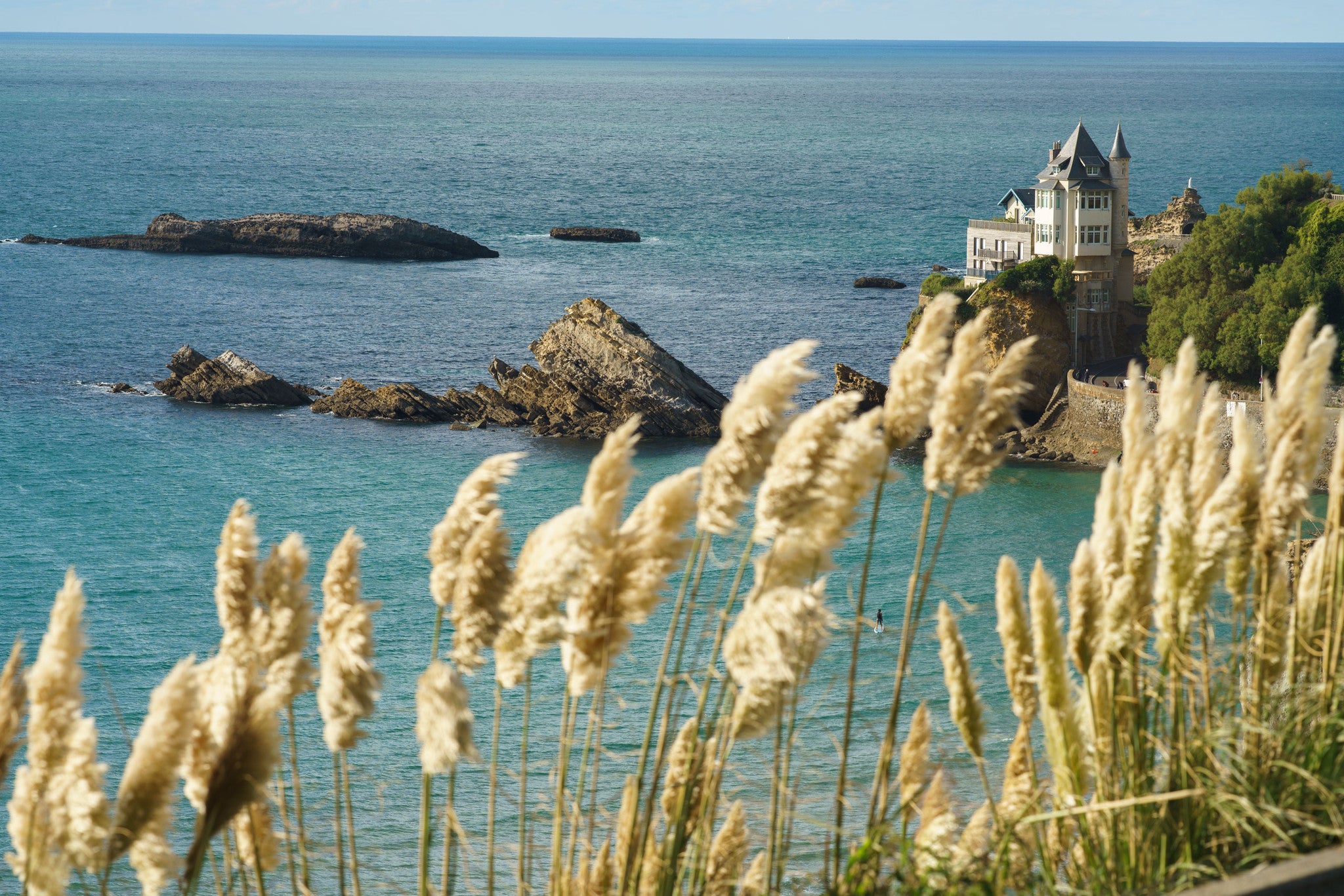The Master Of Craft
A Basque Atelier
Euskal Herria
Scroll to explore
The Story
A CONVERSATION WITH
JEAN-JACQUES HOUYOU
ARTISAN FABRICANT IN PAYS BASQUE
Jean-Jacques Houyou is an artisan fabricant, or craftsman, making shoes in the French Basque Country. Just over five years ago, he made the decision to focus the twenty-six year old atelier solely on the making of traditional espadrilles. The shoes, fashioned from natural cotton, jute and rubber, are a style of footwear closely linked to his Basque ancestry. This style is recognized worldwide today, yet Houyou owns one of only a handful of ateliers in the region, continuing the tradition in hopes of preserving a culture of craftsmanship for future generations.

In the beginning, espadrilles were made from products you could harvest around you. In my opinion, we should keep this same spirit.
JEAN-JACQUES HOUYOU, ARTISAN FABRICANT
S+O — WHERE IS THE BASQUE COUNTRY?
Houyou — The Basque Country is comprised of seven provinces, four of which are in Northwestern Spain, and three are in Southwestern France where I am from. We live in separate countries. We have different landscapes from the coast to the inland valleys and mountains, but there are shared traditions that unite us.
S+O — WHAT DO YOU ENJOY MOST ABOUT LIVING IN THE BASQUE COUNTRY?
Houyou — I don’t know how to explain it… It’s something in my roots. I have the impression that I am the extension of the land. It gives me serenity, well-being and security to be surrounded by the mountains here.
S+O — DO YOU SPEAK BASQUE?
Houyou — No, I am Basque, but I do not speak Basque. I should blame that on my parents, but I won’t because the circumstances were different. When my father went to school, he only spoke Basque. By the time I was in school, we were only allowed to speak French and students who spoke Basque were reprimanded. Now, it is very popular to speak it here again. However, I am not courageous enough to learn it. It can be learned, but it is a very complicated language that is learned easier when you are young.

S+O — HOW DID YOU BECOME A SHOEMAKER?
Houyou — Surprisingly, I didn’t choose it. Looking back, I tell myself it’s the only thing I could have done. Espadrilles are an important symbol of the Basque culture. My family was not in the business of making espadrilles, but I saw my mother, grandmother and great-grandmother hand-sewing them all the time. Due to this, I feel I was born into it. I was trained to be a shoemaker when I was young and spent time traveling and learning the craft. I was lucky to have met a man who was a third generation espadrille maker, making them all by hand. I believe I inherited his passion. And at twenty-six, I returned to my hometown Mauléon to open my own atelier. Mauléon is a small village in a valley that was developed thanks to espadrilles, and my whole career has been centered around these shoes.
S+O — WE’VE SEEN SO MANY VARIATIONS OF THE SHOE ON THE MARKET. DO YOU SPECIALIZE IN A CERTAIN STYLE?
Houyou — Our passion is traditional espadrilles. They are made by hand and with the most natural and local elements possible- jute, cotton and rubber. There is a natural relationship between the land, the people and the product.
There is a
natural relationship between the land, the people and
the product.
S+O — HOW ARE THE SHOES MADE?
Houyou — It is a lot of work to make a pair of espadrilles. All of the steps are completed manually. The first step is to braid the jute rope that will be spun into a warp that molds the sole. There is a metamorphosis, because we move from a large sole to a fine and beautiful form. After the sole is made, we apply the rubber to the bottom. We only use uncolored rubber, but we’ve added citronella oil to scent the rubber and help keeping insects away since the shoes are made from all natural materials. Then, there is the work that makes the espadrilles the most attractive. This is the hand-stitching of the cotton fabric. Currently, we employ twelve women that sew by hand from home.




S+O — HOW MANY PAIRS TO YOU MAKE A YEAR?
Houyou — We make about about twenty-thousand pairs per year, which is about seventy pairs per day. It’s not a lot, but we are not looking to make more than that. Our aim currently is to improve our product. To make it better. For that, every detail counts. The vegetable plaiting material is living and changing. One needs to pay constant attention while working and learn to adapt.

S+O — HAS THE REGION PROFITED FROM THE POPULARITY OF THE SHOE AROUND THE WORLD?
Houyou — The town has seen better days, because some sixty years ago there were three thousand five hundred workers in town. Now we have just three thousand five hundred inhabitants in the town. With the majority of the companies closed, we are left with only six companies, and we are the smallest of them all. The demand is high, but we are not able to produce enough espadrilles satisfying that demand. One can never know exactly what the client is looking for, but when they come to us, I believe they are looking for authenticity and the quality of a product that is made in small quantities by hand.
One can never know
exactly what the client is looking for,
but when they come to us, I believe
they are looking for authenticity and
the quality of a product that is
made in small quantities
by hand.
S+O — HOW WOULD SOMEONE RECOGNIZE A PAIR OF TRADITIONAL ESPADRILLES?
Houyou — Traditional espadrilles don’t have a branding mark on them, so we try to do the same. There are many types of solid colors or patterns that are used to fabricate the cotton shoes. A famous style is what is now called the ‘Picasso’ espadrilles, because Pablo Picasso used to wear them. They are a very traditional type with a striped pattern. In fact, the tuiliers, or tileworkers, is a style of espadrilles originally made popular by the tradesmen in Gironde. Some of those, young tileworkers went on to work in the vineyards, so the shoes are sometimes also called vintner’s espadrilles.
S+O — HOW DOES ONE TAKE CARE OF THE SHOES?
Houyou — We usually advise getting the shoes one size smaller. They should be difficult to put on at first, but they will mould and adapt to your foot. There isn’t a right or left shoe. Our elders taught us that we should switch the shoes every time we wear them. This will make them last longer. Otherwise, they conform to the shape and the fabrics will wear out in the same places. I have a pair of espadrilles that I have worn for twelve years without need of repairs. I wear them nearly every day.

S+O — WERE YOU ALWAYS SO PASSIONATE ABOUT ESPADRILLES?
Houyou — Actually, I have worn espadrilles since I was a kid. And I will tell you, frankly, I hated them. I didn’t like them at the time, because all my friends had sneakers and I thought espadrilles were for country people. It was only later on, when I started to understand what they were and what they meant to my culture, that I began to appreciate them. Now I can’t go without them, because I feel so good in them. I don’t feel like I am wearing anything. It is really a connection to the earth.
Credits
Photography by Brian Sokol
Film by K23 Films
Special Acknowledgements: Mechthild Pelayo
The Objects
Exclusive Edition 003 BASQUE ESPARTINAK
These espartinak, or espadrilles as they are more commonly known, are made in the French Basque Country town of Mauléon by the artisan fabricant Jean-Jacques Houyou. One of six remaining ateliers in the own, Houyou has dedicated his workshop to the making of traditional espadrilles using the most simplistic materials and tools of the trade with the exception of one innovation. He uses natural citronella fragrance blended in with the rubber to dissuade insects from being attracted to the biodegradable materials that construct the shoes. Available only through Stories + Objects, the striped espadrilles come with a washed canvas duster bag to store the shoes in.
The Destination
Euskal Herria
The Basque Country, known as Euskal Herria in the Basque language Euskara, is one of the most stunning regions of Europe. Inhabiting Northwestern Spain and Southwestern France, its landscapes extend inland from the beautiful Atlantic coast to verdant rolling hills to the impressive peaks of the Pyrenees mountains. Travelers are taken with the aristocratic architecture of Biarritz and the Basque houses that line the hills of the charming seaside villages Saint Jean du Luz and Hondarribia. At the same time relaxed and regal, all who visit are as in awe of the pounding surf at Mundaka as they are in awe of the culinary curiosities of Donostia-San Sebastián, where one will find the highest concentration of Michelin starred restaurants in the world.



